.PNG)
PRAYER AND LITURGY POLICY
In its simplest form, prayer is defined as “talking to God.” It is a personal time of opening our hearts to our Heavenly Father and bringing everything in our hearts to Him. Through the Apostle Paul, God asked us to pray. Prayer can be a powerful force for change in our lives, and the importance of doing it on a daily basis should be instilled in our children. Communication is the foundation for success in any relationship. When we communicate openly and freely with each other, we learn to know each other as individuals. This principle also applies to our relationship with God. By talking to God, we can learn more about who He is and what plan He has for us.
Prayer Has a Purpose
It is important that our children understand that there is a purpose to prayer. Jesus frequently prayed during His life on Earth. He had a reason for doing so. Our prayers are something that God deeply desires. But our prayers are not for His benefit; as a perfect Divine Being, God is complete in His power and knowledge. Children are encouraged to pray in different ways according to their age and personal development. The most important aspect of prayer for children is that they realise it is their way of communicating with God and is first and foremost a personal occasion.
Key Elements of Prayer and Liturgy
Ritual
Ritual is a fundamental human activity. The word designates a structured group activity that uses words, gestures, symbols, and movement that have been used by others over time. Human beings use rituals to express some of the things that are significant to them, such as their shared identity. Rituals highlight the things that are most important to people, and reinforce and pass on the values, beliefs, and inner relationships of their group. Rituals are learned by participating in them. Not all rituals are religious – schools ritualise key moments in the journey their pupils make during their life in school, and they also highlight the calendar of the school year. For example, the departure of leavers is marked by a cluster of special activities and events. What makes these events different from other structured events (e.g., calling the register or bringing an end to breaktime) is that they have layers of meaning and are not simply routine. Christianity brings a particular and unique dimension to ritual because of its belief in the Incarnation: the fact that the Son of God assumed a human nature in order to accomplish our salvation. God has reached out to humanity and is encountered in the humanity of Christ. Christian ritual, therefore, takes Christ as its primary focus, believes in his promise to be present where two or three are gathered, and continues to take seriously that God acts in and through the material universe. At the core of the Catholic Church’s ritual life, therefore, is the celebration of the Sacraments, which draw richly on symbols taken from the natural world and mark significant changes in people’s lives.
Scripture
One of the distinctive aspects of Catholic prayer and liturgy is the centrality of scripture.
Scripture has its proper place in all liturgy or celebrations of the word. This is most evident in the proclamation of readings, but will also be found in the prayers we say and the chants we sing. In doing this we open ourselves to listen and respond to God, who is present among us when scripture is proclaimed. It is not permitted to introduce readings from the sacred texts of other religious traditions in any time of prayer or liturgy, nor can the readings in the liturgy of the word be replaced by non-scriptural material. For the Mass and other sacramental celebrations, the readings which are proclaimed are found in the Lectionary. This is a series of volumes for Sundays, weekdays, the celebration of the Saints, and other occasions. For some celebrations, such as a holyday, the readings are laid down and may not be changed; on other days there may be a number of choices to be made. Any choice needs to strike a balance between the integrity of the scriptural passage on the one hand and the needs of the participants (the pupils) on the other. The Directory for Masses with Children offers a number of options, such as the omission of a reading other than the Gospel or the shortening of the text. Care should be taken when editing a text so that the reason for it being chosen is not lost. Pride of place is given to the proclamation of the Gospel. The importance of the Gospel is signified in Catholic liturgy by various actions. These include standing up and singing the Acclamation. Consideration may be given to incorporating some of these actions whenever a Gospel passage is proclaimed in prayer or liturgy. From the first Sunday of Advent 2024 there will be a new Lectionary for England and Wales. The scripture texts are taken from the English Standard Version – Catholic Edition and the Abbey Psalms and Canticles, which have been approved for liturgical use by the bishops of England and Wales. From that date, the use of this Lectionary will be the norm for the celebration of Mass and the Sacraments. It is important that pupils become familiar with the proclamation of the biblical text as sacred scripture. Paraphrases of scripture should not be used in prayer and liturgy. The proclamation of scripture is not a self-contained event. Often, either within the prayer or liturgy or as part of the preparation, scripture will need to be introduced so that pupils understand the context and key phrases or images. These things can also be taken up in a reflection on the reading(s). In prayer and celebrations of the word, it can be helpful for pupils to respond in a variety of ways, such as music, drama or movement, written reflection, or in prayer.
• The proclamation of scripture is essential to the liturgy and celebrations of the word.
• Scripture readings cannot be replaced by other texts.
• When the Gospel is proclaimed, it should be a high point and celebrated with signs of reverence.
Symbol
The use of symbols is central to Catholic prayer and liturgy. Symbols are usually drawn from the natural world – for example, water, light, bread and wine, and oil. In this Directory we distinguish between a symbol and a sign. A sign simply points to one thing beyond itself – for example, a road sign directs a driver towards a particular place. A symbol, on the other hand, is more complex. It can point to several different things at the same time; for example, water is used in the following ways: to cleanse, to hydrate, to nourish, to generate electricity, to destroy, and to take life. Whenever water is used as a symbol, each of these meanings can come into play. So, unlike signs, which need to be crystal clear, symbols are ambiguous. This is a positive thing, because the inherent ambiguity of symbols allows them to convey many different layers of meaning, frequently at the same time. All this, therefore, warns us against always ‘explaining’ symbols and thereby reducing their meaning. The context in which they are celebrated points to the meaning. Thus, the use of water in baptism picks up on the potential uses of water highlighted above, including cleansing, death and new life, and nourishment. This breadth of meaning gives the symbolic use of water in prayer and liturgy a richness that a simple sign cannot convey. For this reason, there are three basic principles to be borne in mind when incorporating symbols in prayer and liturgy:
• Authenticity: in celebrations of the word and liturgy, symbols are meant to be used. For example, the symbolic use of light is to illuminate, highlight, and provide a clear focus. Therefore, candles and other lights should have a symbolic function rather than being merely decorative.
• Maintain the focus: within prayer and liturgy, symbols need their own space so that they can speak. It is best to use one appropriate symbol as a clear focus rather than many, which can introduce confusion.
• Generosity: make sure that the symbol is able to engage with and affect the senses of participants. A minimalist approach (a drop of water, a dab of oil, a symbol that cannot be seen) is unlikely to produce the desired impact.
The body in prayer and liturgy
Our participation in prayer and liturgy is not restricted to the words we say and sing, but involves our whole bodies. All our senses can be engaged: by the smell of incense, the splash of water, and the taste of the bread and wine as the Eucharist is received. Through the beauty of art and music, our eyes and ears can be drawn deeper into the mystery we celebrate. Without words, our bodies can be vehicles of prayer. As with all prayer and liturgy, we do not do these things in isolation. Through the power of the
Holy Spirit, our shared actions, and the sounds and movements we make together in the liturgy, not only express and help create our fellowship with one another, but also by grace foster our communion with Christ and with each other. Thus, standing and singing together at the beginning of Mass not only helps us to be a sign of the unity of those who gather, but also to become one body in the liturgical celebration. There are three aspects to the ways in which our bodies participate in prayer and liturgy:
Movement: liturgy is not static and will involve a number of movements from one place to another. The Mass can be seen as a series of processions (Entrance, Gospel, Gifts, Communion, Sending out).
Posture: in the liturgy, we adopt a number of postures: standing, kneeling, sitting. We do these in common (unless impeded). Each has its significance: standing as a sign of the risen Christ and of reverence; kneeling as sorrow, humility, and adoration; and sitting as a sign of openness and listening. Other postures include bowing and genuflecting, both of which are signs of reverence.
Gesture: the sign of the cross, how we hold our hands in prayer, and the sign of peace are all gestures found in the liturgy. Pupils learn these so that they are comfortable making them and understanding them.
• It is important to be attentive to the physical, embodied aspects of prayer and liturgy.
• Pupils should be confident in the postures and gestures of prayer and liturgy, and use them in expression of their faith and prayer.
Silence
Pauses for silent prayer and reflection play an essential part in any prayer or liturgy. These can be the brief pause between one part and the next; the pause for prayer or petition in the Collect or the Intercessions; longer periods of reflection after the readings or Communion; or sustained periods of silence as found in Christian meditation or Adoration of the Blessed Sacrament. In each silence there is a purpose, to reflect on what we have heard or experienced and to prepare us for what comes next. It is an opportunity to listen to the Holy Spirit speaking in our hearts. Times of silence should ideally be found in any prayer or liturgy.
Prayer Focus Areas
Every classroom and various areas around the school have dedicated Prayer Focus areas. These will always reflect the liturgical season and are a place where children are aware that prayer is central. They will often involve the Class Book of Names, a candle and the Bible. Often theses prayer spaces have prayer boxes where the children know that they can offer up some of their own personal prayers and these will be shared/prayed for in our Whole School Assemblies. Have a look at some of our examples of our prayer areas below:
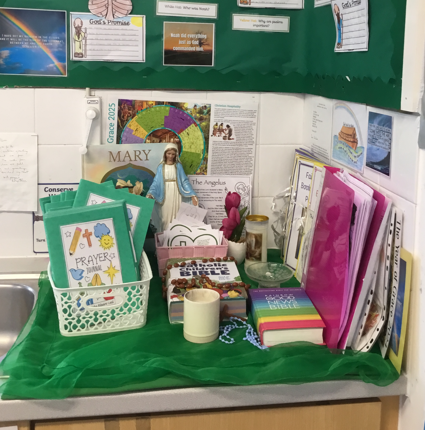
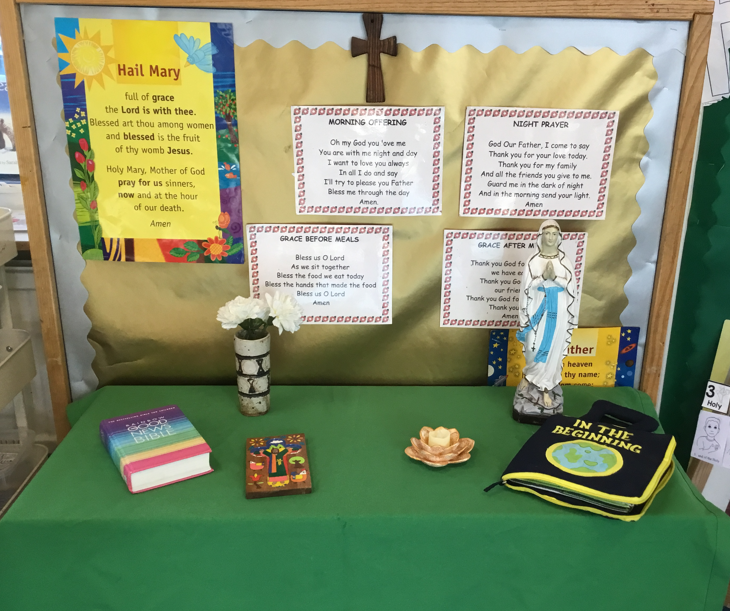
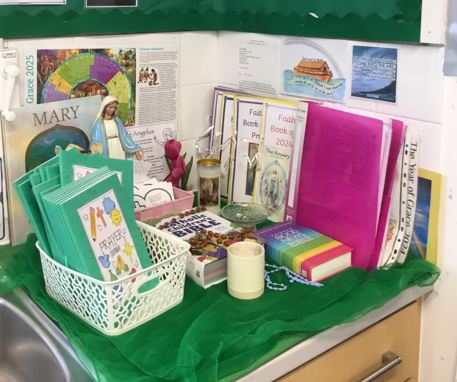
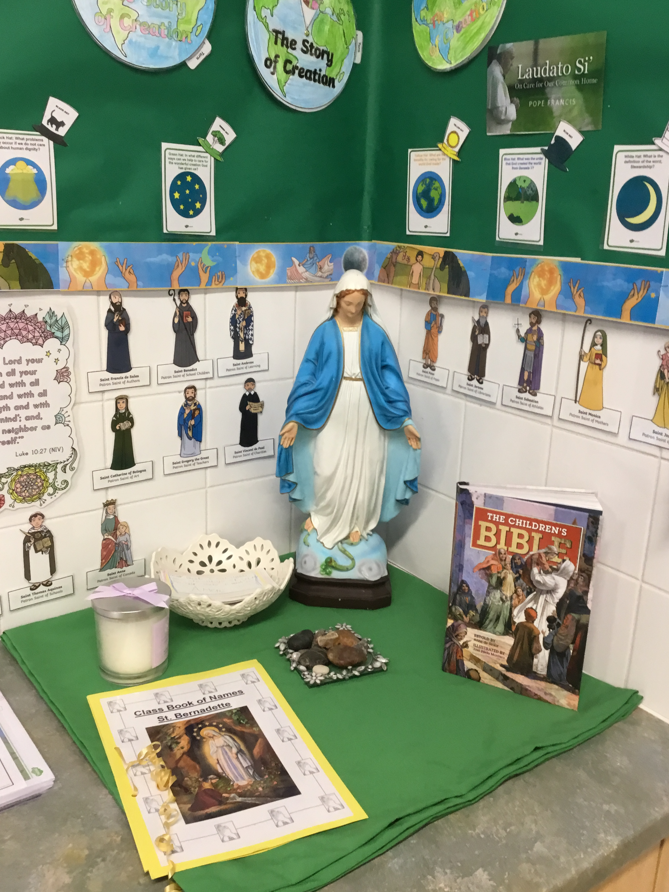
As a school we endeavour to expose the children to and encourage them to participate in as many different forms of prayer and devotion as possible. Some of these examples include:
-
quiet reflection / meditation
-
praying together
-
writing their own prayers
-
prayers through music
-
learning traditional Christian / Catholic prayers
Collective Worship: As a Catholic primary school collective worship plays a fundamental part of daily school life and enables us all to join together as one in prayer and worship.
Hymn Practice: On Tuesdays each Key Stage gathers together to sing songs of praise to God and practise hymns and songs that we use for our collective worship and for Mass.
Phase Assemblies: Each Phase (Reception and Key stage one, Key stage two) gather together each week for collective worship linked to the liturgical season or other religious themes such as Saints or virtues. Teachers from each key stage take turns leading the children in worship.
Whole School Celebration of the Word: Every Wednesday, our school community comes together for a Celebration of the Word assembly. We listen to the Gospel reading and spend time together contemplating what we have heard and reflecting on how this may impact on our lives and what we may be able to learn from it.
Child Led Liturgy: Each week, different children in each class prepare and lead their class in worship. In key stage one the children are guided by adults to prepare for this. In key stage two the children are working to develop their independence when planning their own worship.
Teacher Led Liturgy: Teachers plan a weekly worship for their class to allow time for reflection and prayer based on a religious theme- this may be a stand-alone liturgy or as a moment of reflection prior to the start of a lesson.
Mass: Throughout the year we have the joy of celebrating the Sacrament of the Eucharist in Mary Mother of God Church which we are fortunate to have next door. Children help to prepare and lead the Mass through Altar Serving, reading and bringing up the gifts during Mass. On every occasion parents and guardians are invited to join us for Mass.
Liturgies: Throughout the year, to mark important events in the Church’s liturgical year, we hold special Liturgies or Masses such as Harvest Festival, Sacrament of Reconciliation, Benediction to name a few.
Rosary: Every October and May, we invite children and their families to join us in praying a decade of the Rosary after school. It is a lovely opportunity for us to join as a community and pray together to the Patron Saint of our school; Mary.
Individual Prayer: All children have access to a personal Prayer Journal which they know they are able to use at any time to write down their own personal thoughts or prayers or to use as a moment of quiet reflection after a classroom celebration of the word or a quiet meditation.
PRogression of prayer
ST MARY'S PRAYER BOOK
Parish Connections
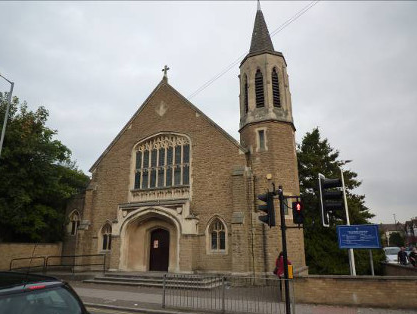
As a school, we strive to work in close partnership with our local Parish which we are lucky enough to have a mere stone’s throw away from our school. From class visits to regular celebrations in the church, we work as a community to nurture the spiritual lives of our children. So many of our current – and past - pupils give up their time to become altar servers and to sing with the church choir or become active members of the Liturgy Team which we feel is testament to our sense of community.
School Mass
It is a priority as a Catholic school to foster an understanding of the faith, which is why we teach our children how to worship in a formal setting from a young age. We attend Mass as a school on a regular basis to celebrate; Feast Days, Saint Days and important moments in our school calendar. Our classes take it in turn to attend a Mass on a half-termly basis where they recognise the importance of respect and reverence and what is expected of them in a church setting. We encourage the children to take part in singing, prayer and communion when they join us in celebration.
Sacrament of The Eucharist Year 3 is an important year in the spiritual lives of our children. The school support the parish in offering the opportunity to grow in their faith and to encourage children to take part in the parish First Holy Communion Programme. Attending classes after at the weekend, the children begin to nurture a more in-depth understanding of their faith and learn how to live a more spiritual life, culminating in a wonderful celebration in the church with friends and family in the Summer Term.
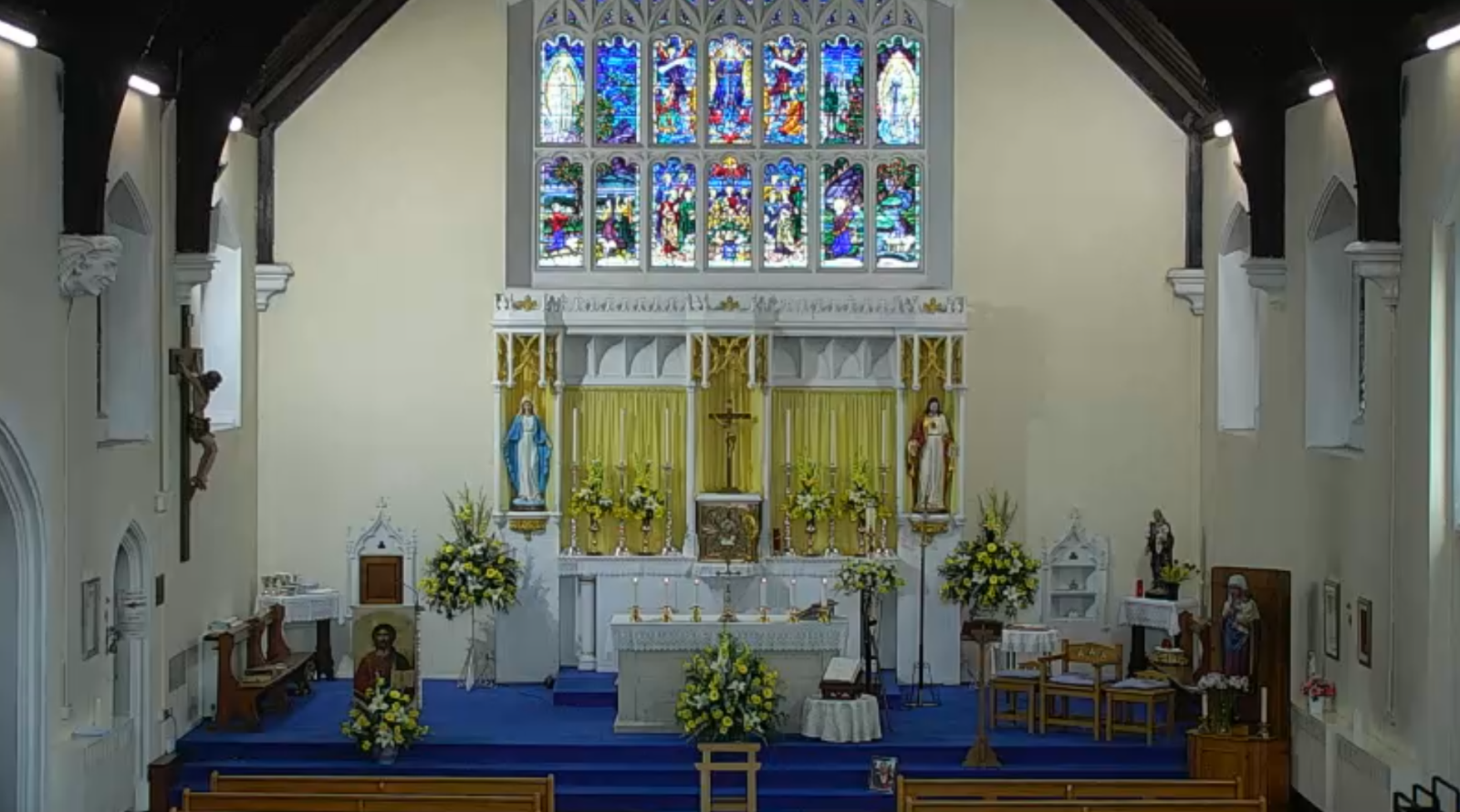
Links with home
As a school we recognise the importance of working with parents and carers on our mission to develop the whole child in a spiritual, moral, academic, physical, social and emotional way. At the start of each academic year a ‘Meet the Teacher’ takes place for each class where parents are invited into school to familiarise themselves with their child’s new classroom and ask any questions they have to the teacher. There are 2 further opportunities for parents to meet with their child’s teacher throughout the year though they are always encouraged to get in contact with the teacher whenever they feel they need to; each year group has an email address where parents are able to be in direct contact with the teacher if need be. Monthly newsletters are sent home to parents all of which can be found here where they are kept up-to-date- with all aspects of school life. They receive a copy of the Wednesday Word every week in order to celebrate the Gospel as a family. Mums, Dads and Grandparents are invited into school for a morning each year to allow them to spend time with their child in class, to see how they learn and to strengthen the links between school and home. Parents and families are always invited to and encouraged to attend school or class Masses to enable us to celebrate together as a community.
Prayer Intention
An open space for any personal prayer intentions that can be added to our liturgy, masses and personal prayer moments. We understand the power of prayer in our school community.